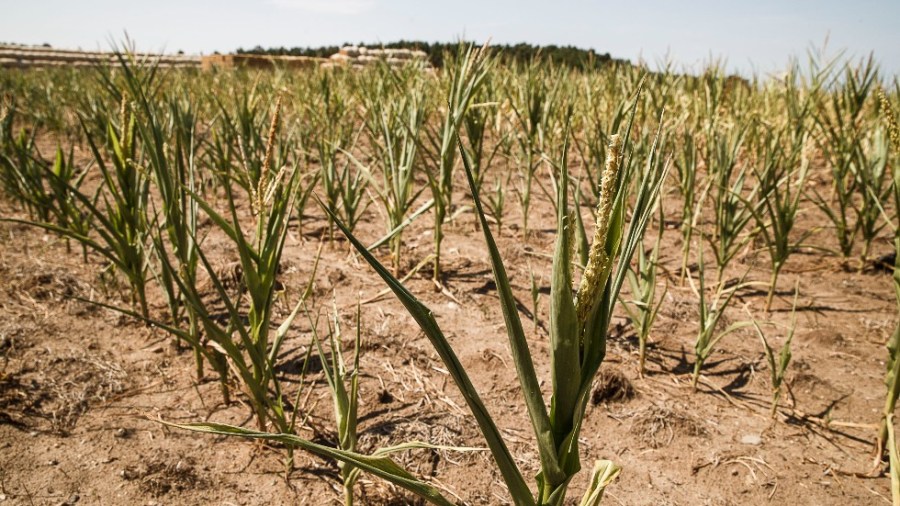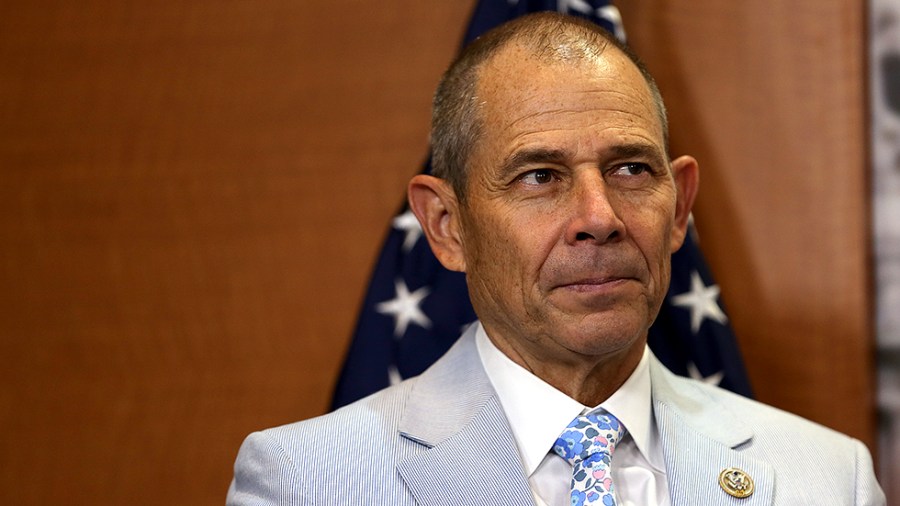Equilibrium — Presented by NextEra Energy — A new final frontier: Washing dirty laundry in space

Today is Wednesday! Welcome to Equilibrium, a newsletter that tracks the growing global battle over the future of sustainability. Subscribe to the newsletter here: digital-stage.thehill.com/newsletter-signup.
As Western U.S. residents wrap up workouts with two-minute Navy showers amid unprecedented drought, they might soon benefit from gadgets geared toward extraterrestrial exercise.
NASA is teaming up with Procter & Gamble Co. to develop a washer-dryer combo that could eventually operate on the moon or even Mars using minimal amounts of water and detergent, the Associated Press reported. Up until this point, astronauts dealt with their tons of dirty laundry each year by throwing it away: launching their garments to burn up in the atmosphere aboard discarded cargo ships, according to the AP.
Because astronauts exercise two hours daily to minimize the muscle- and bone-withering effects of weightlessness, their clothes are left so sweaty and stiff that they take on “a life of their own,” according to Leland Melvin, a former NASA astronaut and NFL player.
It’s also a nice case study in the problem of living in a closed system — like, say, Planet Earth, where we are looking today at how some 80 million people around the world could go hungry by mid-century without — or by this point, perhaps even with — drastic climate action. And we’ll also examine how the Republican Party is tiptoeing into America’s discussion of climate change.
For Equilibrium, we are Saul Elbein, operating out of Washington, D.C., and Sharon Udasin, based in Boulder, Colo. Please send tips or comments to Saul at selbein@digital-stage.thehill.com or Sharon at sudasin@digital-stage.thehill.com. Follow us on Twitter: @saul_elbein and @sharonudasin.
Let’s get to it.
A MESSAGE FROM NEXTERA ENERGY
As the world’s largest producer of wind and solar energy, NextEra Energy is pioneering innovation on green hydrogen – the solution for deep decarbonization of hard-to-abate sectors. See how at NextEraEnergy.com.
Climate change will lead to mass starvation — and that’s the best case scenario

Up to 80 million people could face starvation by mid-century and up to 140 million could become climate refugees, according to a leaked U.N. report acquired by the UAE-based English daily newspaper, The National.
“Totally vulnerable”: Among other things, the draft report from the Intergovernmental Panel on Climate Change (IPCC) predicts that climate will drive massive disruption of freshwater supplies, diminish or even wipe out harvests of key cereal grains like corn and rice across broad swaths of the globe and lead to plunging nutritional content in the food that remains.
“The basis for our health is sustained by three pillars: the food we eat, access to water and shelter,” Maria Neira of the World Health Organization, told The National. “These pillars are totally vulnerable and about to collapse.”
An overwhelming list. Since the IPCC report synthesizes existing scientific literature, none of this is a surprise, Katharine Hayhoe, an atmospheric scientist at Texas Tech, wrote on Twitter. But the results, from drought to wildfire to accelerating sea level rise, “hadn’t been pulled together into one overwhelming list.”
For most people, Hayhoe noted, seeing that single list highlights just how novel and dangerous our current level of carbon emissions is.
“It’s as if we’ve been driving down the road looking in the rearview mirror: but now we’ve hit a dangerous curve & our wheels are teetering on the edge,” she tweeted.
Dueling definitions of caution: One concern that Hayhoe, like many climate scientists, has noted: The IPCC, by its very nature as a consensus organization, tends to focus on the least controversial, most established science. Doing so can leave it blind to “tail risks,” which as we noted Tuesday are unlikely, but pose potentially lethal black holes in our planning.
Back in 2013, climate scientist Naomi Oreskes coined the term “ESLD,” for “erring on the side of least drama,” to describe the tendency of IPCC reports to be “biased toward … less rather than more alarming predictions.” It’s caution about freaking people out, in other words, rather than caution about avoiding tail risk.
What this means: As scary as the U.N. report sounds, it could actually be lowballing its estimate.
BARRELING BLINDFOLDED TOWARD TIPPING POINTS?
A line of climate dominoes: One reason climate change is so dangerous and hard to plan for, as Radley Horton of Columbia University’s Earth Institute told Equilibrium, is that it leads to “cascading systems” of collapse that are very difficult to predict.
For example, as a recent paper in Earth System Dynamics found, the failure of one key “tipping point” of the Earth’s climate system — the disintegration of the Greenland or West Antarctic ice sheets, the end of the spinning Atlantic or El Nino currents or a massive dieback of the Amazon rainforest — could lead to the failure of the others, like dominoes in a line.
Takeaway: Climate scientists have long argued that the existence of such tipping points — and our ignorance of precisely when we will reach them — makes immediate carbon emissions reductions a priority. It’s one reason why 11,000 scientists signed an open letter in January warning of the “catastrophic threat” of the “climate emergency.”
As Hayhoe, the Texas Tech climate scientist noted on Twitter, “Climate change isn’t just one more priority on our already over-crowded list. It is a threat multiplier that affects every single other priority already on it.” To care about it, “we only have to be one thing,” she added, “and that’s a human living on this planet.”
A MESSAGE FROM NEXTERA ENERGY
We’re pioneering innovation on green hydrogen – the solution for deep decarbonization of hard-to-abate sectors. See how it can create jobs, accelerate economic growth and more at NextEraEnergy.com.
Republicans see inaction on climate change as existential threat — to their party

A new group of humans — one that used to want no part in discussions about surviving the climate crisis — is now entering the fray.
House Republicans announced Tuesday that they would be launching a caucus aimed at educating its members about climate change on Wednesday, Rachel Frazin reported in The Hill.
The caucus, spearheaded by Rep. John Curtis (R-Utah), will not be endorsing any specific policies. Instead, it will provide members with information and strategies for talking about climate change, Frazin reported, adding that the caucus’s launch comes while the GOP has been walking back from denying that climate change is occurring.
“Early on, when I was asked in town hall meetings if the climate was changing and man was influencing it, I would not answer that question. I would dodge that question. I don’t think I knew the answer to that question,” Curtis told The Hill on Tuesday.
How did a GOP climate confab come to be? When Curtis first approached fellow Republicans to discuss climate issues at a secret meeting in Utah, he initially hoped that a half dozen people might agree to attend, Lisa Friedman reported in The New York Times. But for two days in February, 24 Republicans gathered in Salt Lake City to brainstorm ways “to engage on a planetary problem it has ignored for decades,” Friedman wrote, adding that for four years under the Trump administration, the phrase “climate change” was verboten.
But today’s Republican Party is increasingly understanding that there must be a shift, as independents, suburban voters and young Republicans call for the government to take action on climate issues, according to the Times piece.
“It’s my hope that any Republican that belongs to this caucus, if asked about climate in a town-hall meeting, will feel very comfortable talking about it,” Curtis told the Times, adding, “I fear that too often Republicans have simply said what they don’t like without adding on ‘but here’s our ideas.’ ”
QUESTIONS FOR REPUBLICANS
Goals of the Conservative Climate Caucus: While the ambitions of the so-called Conservative Climate Caucus remain vague, members say that they intend to contrast their ideas with “radical progressive” climate policies, like pricing carbon or requiring clean electricity use, Josh Siegel reported in the Washington Examiner.
Caucus Republicans — who now number nearly 40 — maintain that fossil fuels can remain “a major part of the global solution,” as long as emitters are using “innovative technologies” to mitigate pollution, the Examiner piece said.
Many Democrats have criticized caucus Republicans for their stance on fossil fuels, arguing that their plans will fail to curb the most damaging impacts of climate change, according to the Examiner.
Other GOP plans to tackle climate change:
- House Minority Leader Kevin McCarthy (R-Calif.) plans to start a Republican task force on climate change, his staff confirmed to the Times.
- On Earth Day, McCarthy introduced a package of bills that supported capturing carbon emissions generated by power plants, as well as planting trees and expanding nuclear energy — a carbon-free energy source preferred by many Republicans over wind or solar, as Friedman reported in the Times on Wednesday.
- The Conservative Climate Caucus may be sending an independent delegation to November’s U.N. Climate Change Conference (COP26) in Scotland, according to an E&E News piece (paywall), which described these efforts as “elbowing into a White House effort to rebuild credibility on the world stage.”
Questions remain: John Walke, clean air director for the Natural Resources Defense Council, tweeted several questions regarding the caucus’s plans on Wednesday morning — asking whether members will support the target to achieve net zero emissions by 2050, whether they will submit legislation related to reducing that target and whether they will “protect local communities in a just, safe transition toward that target.”
ROUND-UP
WEIRD WEDNESDAY

A collection of things that aren’t quite as they seem: Freedom for the Uyghurs in Xinjiang, derelict dumps reclaimed as solar sites in New Jersey, a populist insurgent in Idaho and Biden’s public-lands fracking ban.
New York Times, ProPublica surface propaganda videos from repressed Xinjiang region, which is also a critical manufacturing zone for global cleantech
- Thousands of videos “meant to look like unfiltered glimpses of life in Xinjiang” — a Western Chinese region where the Communist Party has long repressed Uighur Muslims — are the results of official Chinese government propaganda, a months-long analysis by The New York Times and ProPublica has determined.
- About one-third of the polysilicon used to make the world’s solar panels hails from the region, with China as a whole accounting for about 80 percent of global capacity, according to an October report from S&P Market Intelligence.
- Even if the American solar industry tried sourcing polysilicon from other parts of China only, the Australian Strategic Policy Institute has warned that Uyghurs have been forcibly transferred out of Xinjiang to work in other parts of China, according to S&P.
U.S. solar developers looking at post-industrial America as a land of opportunity
- Wind and solar take up some 10 times as much land as fossil fuels to produce the same amount of electricity, Dane Rhys and Nichola Groom reported in Reuters. That can make it challenging to find spaces that don’t create new environmental problems or take away from valuable urban real estate.
- That’s why they’re going in on valueless real estate. As of last year, there were more than 417 renewable energy installations on formerly contaminated lands in the U.S., Reuters reported, citing the Environmental Protection Agency.
- In New Jersey, the most densely populated state in the country, solar projects on contaminated lands receive preferential treatment under a renewable energy credit market, according to Reuters.
- Today, the state has 25 such projects that make up more than a quarter of its utility-scale solar capacity, the report added.
Ammon Bundy, opponent of federal jurisdiction of public lands, runs for Idaho governor
- Bundy, son of rancher and populist activist Cliven Bundy and a leader of two armed occupations of federal land, is running for governor of Idaho, Paulina Villegas reported in The Washington Post (paywall).
- In a state whose territory is 61 percent owned by the federal government, Bundy has called for the state to take over federal lands, the Post reported.
- His candidacy is buoyed by the fact that “in American politics it’s a good time to be in the ideological extreme,” Jeffrey Lyons, of Boise State University, told the Post.
- But Tom Luna, chairman of the Idaho Republican party, told the Post that it would not support him, noting that some of Bundy’s positions — particularly a vocal support for Black Lives Matter and the campaign to “defund the police” — “are more aligned with the Democratic Party.”
Biden reverses plan for “permanent” ban on new fracking on public lands
- On Wednesday, Secretary of the Interior Deb Haaland told the House Committee on Natural Resources that the White House doesn’t have “a plan right now for a permanent ban” on new oil and gas drilling on federal land.
- This comes after a June 15 ruling from a federal judge in Louisiana that the administration could not pause the sale of new oil and gas leases while it fended off a challenge from 14 GOP state attorneys general, Coral Davenport reported for The New York Times.
- Biden does have the authority to do so, industry groups told Reuters reporters, who noted that the pause “was widely seen as a first step to delivering on his campaign promise to permanently ban new federal leasing to fight climate change.”
- But Mitch Jones, policy director of Food & Water Watch, said “it now seems that Biden has no intention of keeping that promise,” calling the reversal a “disastrous capitulation to the fossil fuel industry.”
{mosads}Later this week, we’ll be looking at new international best practices to avoid “greenwashing” — when companies overstate their positive environmental impact — and we’ll see if the second time’s a charm for a new bipartisan clean energy standard.
Also, don’t miss our latest piece on managed retreat, which dropped Wednesday.
That’s a wrap, folks. Thanks for reading Equilibrium. See you tomorrow evening.
Copyright 2023 Nexstar Media Inc. All rights reserved. This material may not be published, broadcast, rewritten, or redistributed. Regular the hill posts









